|
|
|
Trip with the ferry to the island Thassos
After the visit of Kavalla, we moved with a car ferry to the island Thassos, visited there the city of Thassos and made an island tour with spectacular sightseeings and visits. Of course, a relaxing bath in the sea was not missed out. From Kavalla to the city of ThassosIn the ferry harbour of Kavalla we had our first positive surprise. The car ferry to Thassos, which loading platform was already nearly closed, opened again, so that we could continue our trip. The only thing that was strange is the fact that our vehicle was the only one that was looking to the others. Therfore we planned to be more than punctual by arriving at Thassos. At home, we would have had to take a waiting time of three hours. Still in the car, the fare of 27,50 € for the car and 4,50 € per passenger was collected for the trip of 75 minutes - an amount, that was already ok by only considering the fantastic panoramas. The ferry was accompanied by numerous gulls, that launched with adacious maneuvers into everything eatable that the ferry passengers provided them. Well, we were also very surprised, as the prices for food on board were cheaper than expected. Those who are very lucky can also see some dolphins during the ferry crossing but unfortunately, this experience was refused to us. 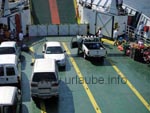
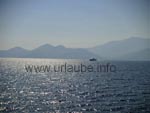
We slowly approximated the shallow hills of the most northern Aegean island, that culminated in the interior in the mountain heighted 1204 m Ypsario and emerged more and more clearly in the mist over the water. Still ten years ago, Thassos was considered to be the most green islans of Greece, but then a devastating forest fire destroyed large parts of the forest stand. Thus we were very curious to see to which extend the vegetation had recuperated. Arrived at Skala Prinou in Thassos, there was no trace of visible damages. Just the opposite - the arrival resulted to be like diving into a little paradise: green mountain sides, yellow sandy beaches, sea water glimmering at the sun - and no kind of intrusive buildings. Our three felt balls could even manage to be punctually back to the car, so that we twosome could manage to drive the car backwards off the loading platform of the ferry which end was a little bumpy and put the vehicle ungently on Thassos. 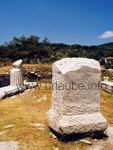
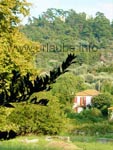
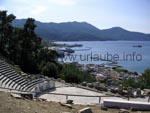
The drive continued further to the east of the island, first a cliffy, curvy and shady dream road upwards, then downwards in direction to Thassos city, that is the biggest city of the island with 3000 inhabitants. A multitude of antique places in the area of the downtown (antique harbour of war and trade, diverse excavations of temple complexes), but also the market place (Agora), the amphitheatre, the Akropolis and the remanings of the city wall with a length of four kilometres in the upper part of the town testify their eventful history that goes back up to the 7th century BC. From the upper city, that is located 140 metres above the city of Thassos, a specially impressive view is presented over the white houses and the sea that goes up to the mainland to Kavalla. Chrisi Ammoudia: Golden BeachAfter a short walk on the lively boardwalk of the harbour in the city of Thassos with its taverns and bars and a side step over the shopping mile of the city, we further drove to Chrisi Ammoudia to the "Golden Beach", over which the Ypsario guards from the background. The massif, that surrounds the beach as a kettle, provides calm and very high temperatures in the midday hours, but there are enough parasols and deck chairs that could be rented together for a fee of 5 euros per day. 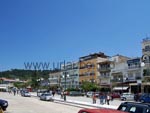
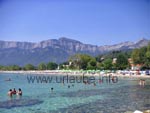
The beach itself is white, fine-grained and clean and corresponds, not at least because of its backdrop, to the concept of a storybook - beach. However, we had perfected there the art of extremely bobbing up and dowm on the inflatable matress. Also for children, the "Golden Beach" is very recommendable, as it is absolutely possible to go 50 metres far into the sea, until the water goes up to an adult's hips. The swell in the long extended and well isolated bay is absolutely non-hazardous. The island Thassos, and the "Golden Beach" is not an exception, is touristically influenced, even if the most places are not completely flooded by the mass tourism, as the number of the visitors are spread into dozens of beaches that are all well accessible from the coastal road and beautiful. The natives of the mainland are predominantly, but there are also guests from Germany, Austria, Great Britain and the bordering states Albania, Bulgaria and Macedonia having their holidays. Everywhere in Thassos there are little hotels and pensions in the close proximity of the beach and also for the campers there are nothing left to be desired. Five places, all of them optimally equipped, are accessible in Tassos and one of them has a direct access to the "Golden Beach". The "all-inclusive lazy package" is rounded by mobile traders, that step out the beach with fresh specialities at affordable prices and only offer on demand pastries, frappé and other goodies for sale. Those who want can be incured a penalty by buying pirate copied CDs. The coastal road: car tour around the island ThassosBut in Thassos, there are not only sand beaches, of course. The coastal road that is in a very good condition and has a length of 110 kilometres and makes the circling around the island by motorcicle or car within a couple of hours without problems, nearly offers after each of the curves some sensational and new views, whereas the inland roads include the isolated mountain villages as the historical Kazaviti in the north east or the relatively centrally located Theologos with its museum of local history, in which the traditional stone houses with its slated roofs predominate and the time seems to be stopped. 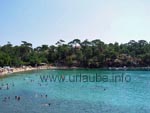
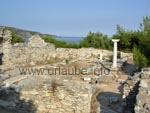
We then went to the aforesaid coastal road after three relaxing hours on the beach and after a half an hours drive alongside the sea, we arrived to the little village Aliki at the south-eastern coast. Here, the factors of holiday and culture can be joined in a perfect way, as on one side, there are numerous antique excavations of the 7th century b.C. visible in Aliki, the time of prosperity of this little place, in which the marble was already mined and exported by sea, thereunder remains of temples and other buildings. On the other side it is known for its both bathing bays with the many taverns and bars, from which one is famous as the "bath tube of Thassos". The reason for this is its peculiar shape that reminds on a bath tube. With a few happy songs from the back seat, we drove, after a short stop, further to convent Archangelou that is about ten kilometres far by Astris in the south of the island, that is constructed on a rock that falls away steeply inot the sea and guarantees a beautigul sight to the Aegean. It is also said about the interior of the convent that, due to its high valued cultural goods it is absolutely worth seeing. But they are not allowed to be photographed, as in Greece it is not well seen that icons and sainthoods are pictured. So in the convent, there is for example a splitter of a wooden cross to be gazed at, on which Jesus should have been beaten. The complex can be only visited in long clothes that can be borrowed at the entrance. 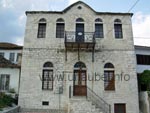
As our tight time schedule did not allow us to handle the remaining hours in a wasteful way on this important day of sightseeings, we aske dour street map for a sidestep destination. Ir was rapidly found, it sname was Theologos and was located a little furthe rin the inland. From Potos, a street leads about ten kilometres into the interior to Theologos. The former isolated village is meanwhile discovered by the tourism, but it still presents itself very traditionally. From above, the slated roofs dominate the image, in the taverns, greek live music is played and the touerists, eaponed with cameras, rush enthusiastically to the abundance of views that represent the mediterranean idyllic. There are little houses made of stone, big old mansions that are newly fettled and painted, a lot of vegetation, narrow alleay, wooden verandas, doors and shutters, a church and a lot of nature around. A similar picture was offered by Kazaviti, that was accessible form Prinos and was the last station of Thassos. The 45 kilometres to Prinos in the north west of the island were accompanied by long sandy beaches and fisher villages at one side, and at the other side by olive groves. The south and the west of the island is more flat and thus better for the agricultural use. Here, the village density is bigger than in the north or the east of the island. From Prinos, the way led us again into the inland, wuere Kazaviti is loceted in an afforested valley. Beside a round through the centre, that appeals by similar aquitectonical characteristics as already Theologos did, the visit to the monastery Agios Panteleimon is worth, that it is equally sorrounded by mountains. It is approximately 1 kilometre from the village and signposted from Kazaviti. But it is not recommendable to visit the convent with a motorized vehicle, as the road to this place is extremely bumpy and holey. It goes without saying that the visited stations are only a fragment of the sightseeings of the island. The fisher villages as also the old marble quarries an countless further antique excavations can be explored. Or the interior of the island with its water falls, forests, an isolated lake. It is developed with a great network of hiking trails, that is recorded in special maps of trails. Thus, for those that the relaxation at the sea is not sufficient, they can also explore one one's own account on foot. Thereby it shouldn't be forgotten that there are also snakes in Thassos which bite can lead to death. I mention here again that the most dangerous ones , the sand vipers, are very small and their head has the shape of a triangle. Those who do not want to take this risk, that is indeed very light if one behaves correctly, can rent at the coast a car or a motorbike. The time that should be planned for the visit of each of the sightseeings, does not least depend on the length of stay in Thassos. If as in our case, the time frame is very limited, an extended car tour around the island with intermediate stops is worthwhile, as all interesting locations are accessible from the coastal road. The significance of the touristical and cultural potential of the island is, of course, very important to the inhabitants of Thassos, but not neccessarily more important than the natural resources that are extracted since the antique epoch. Better said: without them, Thassos would have never been so rich in cultural monuments. Already before 20.000 years, the natural pigment raddle was mined in the island in the oldest downhole mine of Europe, many thousand years later, precious metal ores and non-ferrous metal ores followed, that, as the raddle, are not mined any more. Since the sixties, Thassos is, in the industrial concern, exclusively oriented to the mining of marble and the extraction of petroleum and natural gas. One of the drilling platforms is already visible to the visitor during the ferry crossing. But particularly the marble that is everywhere present in the island, that is mined on a grand scale in huge open pits goafs. While circling the island, one repeatedly encounters deposits of the massive brutes, that are exported by sea route. The material is world famous and an omportant economic source of the island. After an exhausting but also eventful day, we took the last ferry of the evening back to the mainland and enjoyed once again the evening light of the early sunset of September, bofore we ent again on the way to Paleochori, where we wanted to start a little barbecue party. In a wise foresight we were not stingy at the local Lidl in Eleftheroupoli and restocked our beer provisions. Also, we really bought s lot of meat and salads, as the past day reduced our energy resrves a lot. Bach again in Paleochori, some known faces were already expecting us, but it seemed to be now well known that the visitors of Germany arrived. Beside male and female cousins with their families and children, also the sister of the aunt was there. The barbecue and the coal were rapidly found, and shortly before one of the cousins could pour a black liquid that resulted to be used oil over the coals, Kosta again saved the situation after an extended discussion about the pros and cons of used oil. We used commercial fire starters that we bought before. While the men took care on the barbecue, the women were discussing which of the remaining german single women would match the best to Kosta, also a single. As one of them was half-greek, it was said, that the other one could have creamed herself better, as red as her skin was, whereas the aforesaid half-greek could still get more colour. The thing seemed to be already done. However, the food was enough for everybody and the evening ended, as many other times, in a funny german-greek chaos. 
Back to the index Thessaloniki Copyright: Patrick Wagner, www.tourist-guide.biz |
||